Contamination Control In Food Processing Equipment
By Johan Lucas, VP Sales and Business Development at Kemutec Netherlands

The food production industry does not typically require the same application of traditional cleanroom technology as seen in the semiconductor, pharmaceutical and even food laboratory industries. Contamination control, however, is rightly a top priority for food makers as production needs to be conducted within an ultra-hygienic environment – the food processing equivalent of a cleanroom – which is vital in ensuring that health and safety protocols and quality standards are met. As such, food production companies should be looking to harness technology that helps to minimize contamination risks wherever possible.
An inability to prevent contamination occurring, no matter how severe or minor the case is deemed to be, can result in manufacturers failing to pass inspections and can undermine public confidence in their brands. In addition to the above examples, powders such as spices and flavorings are common contaminants, due to their nature as strong tastes that can easily become embedded into grooves on machinery.
This article highlights issues processors experience in preventing contamination and how engineering for contamination control in food processing equipment can be a solution.
Get unlimited access to:
Enter your credentials below to log in. Not yet a member of Food Online? Subscribe today.
